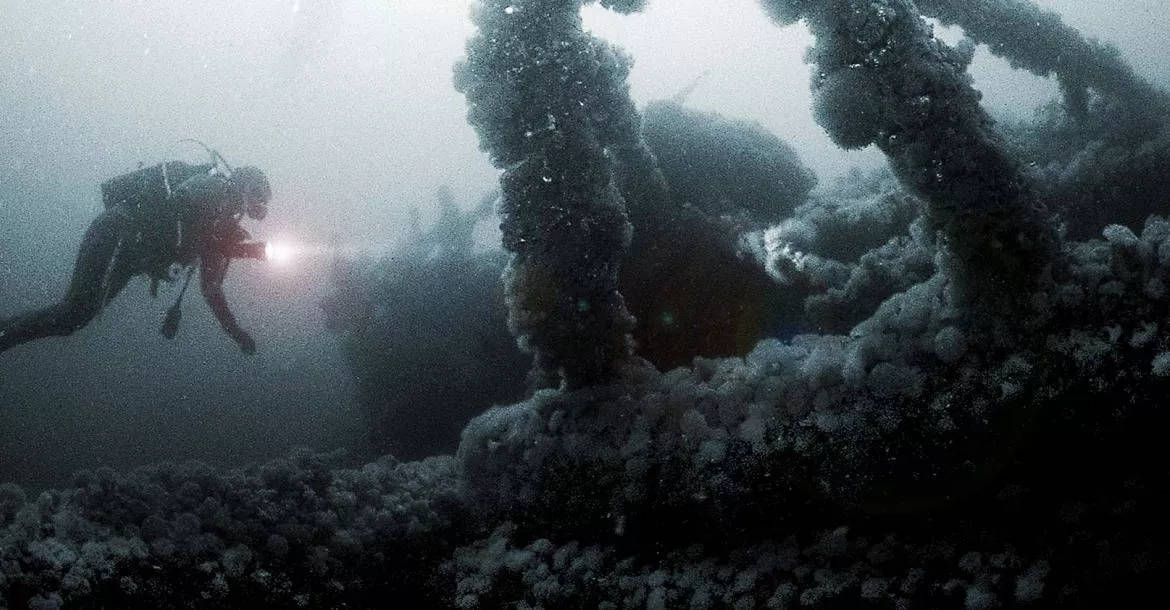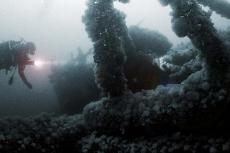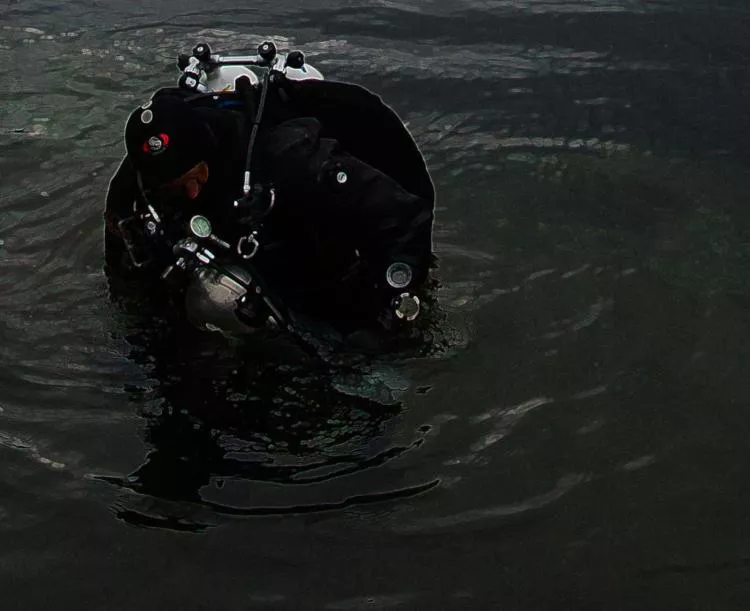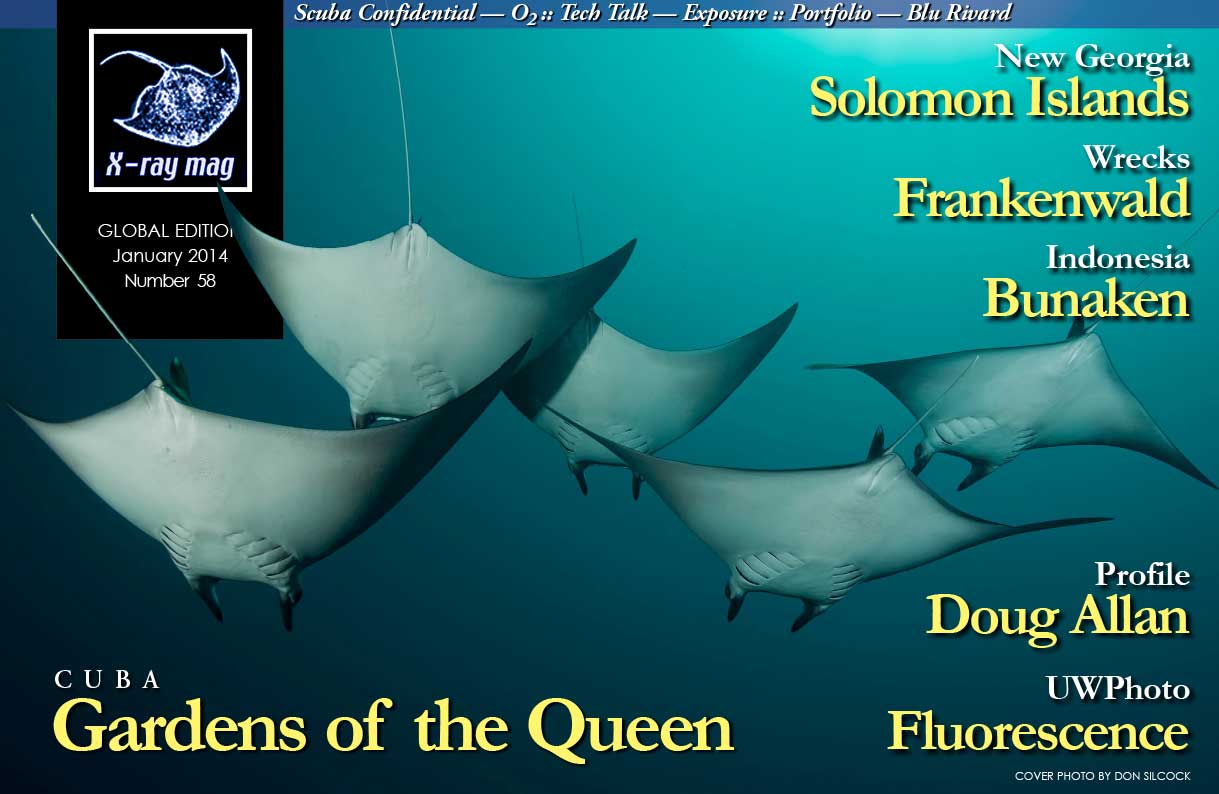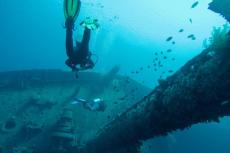The Royal Mail Ship, Empress of Ireland, was an ocean-going luxury liner on her way to Liverpool from Quebec City when she sank in the Saint Lawrence River, 14 minutes after colliding with a Norwegian collier in the early morning fog of 29 May 1914. She had 1,477 people on board—passengers and crew—and the accident claimed the lives of 1,012, more than 800 of them passengers.
I’ve had the privilege to dive on the wreck several times; the first was in the aftermath of Hurricane Hortense, which blew its way up the eastern seaboard of North America, and although it did not hit Rimouski directly, turned that late Quebec summer into a mini-maelstrom.
Contributed by
Factfile
Steve Lewis is an active technical diver and instructor based in North America.
He is an author, blogger and workshop host with a special interest in diver education and the development of safe diving protocols.
He first tried sidemount scuba as a young dry-caver in the United Kingdom, and now many decades later, carries a TDI sidemount cave instructor rating and is an open-water/overhead environment Sidemount Instructor for PSAI.
See Techdivertraining.org
The weather was awful—windy, wet and bleak. It had kept us out of the water and holed up in a small hotel for days, playing euchre and praying for a break in the weather. When a narrow window of opportunity finally opened up early in the morning on our last scheduled day in French Canada, we suited up on at the dock, threw our gear onto our charter boat, and hoped for the best.
The dive was fantastic—truly historic, but my most vivid memory is staring at my dive computer towards to end of it and seeing that I had earned 45-minutes of decompression. The water was between 3°C and 5°C. I had on inadequate thermal underwear, the current changed direction every few minutes and carried a force that varied from the relative comfort of flag-waving three-quarters of a knot to an extremely unfriendly “hold your hat on Maude, we’re going for a ride.”
The only up-side was a seal that seemed to delight in smart-bombing us relentlessly and at regular intervals throughout the various stops from about nine metres to the surface. It took a liking to my fins.
Lessons learned
I learned two lessons about “exposure” that day: never rely solely on a personal dive computer to track your decompression obligation (especially a second-generation dinosaur) because there might be a better way; and the speed at which time passes follows a curve proportional to falling water temperature.
Exposure in the context of diving and more especially risk management in diving, relates to surfacing safely without suffering decompression stress, hypothermia, heat-stroke, or wounding from passing critters, and without drifting off into the cosmos far from your lift back to harbor.
The focus in most texts is primarily on the part of a dive that begins around the time we leave the bottom and ends when we are back on the surface (or more correctly, when our surface interval is over and we know we are safe from DCS). This is the usual focus since DCS is a real risk on all dives even those on which the broader issues such as staying warm and comfortable, surviving other environmental conditions such as current, boat traffic, wildlife, and even being able to pee when the need arises are less compelling!
So, to conform to convention, let’s start with that pesky decompression thing.
Following that first dive on the Empress, I understood viscerally that to follow a dive computer blindly and without question was not the best possible option. It can get one in over one’s head, figuratively and literally. The PDC I was using—a demo from a European manufacturer—suggested I stay in freezing water and horrible conditions for far longer than necessary. Thankfully, my buddy and I carried lots and lots of “spare” decompression gas: most of which was consumed by the time our computers cleared us to surface, since both our respiration rates were easily double our norm.
Back in those days
Bear in mind, this episode was back in the dawn of personal dive computers (PDCs). They were reasonably new and those that did not lock-up when their user exceeded the no decompression limit (NDL), had strangely and well-padded degrees of conservatism built-in.
Adding 80 percent
What made the issue worse was that the user had zero jurisdiction over which level of conservatism was used. It seemed that each manufacturer had its programmers conditioned to think like litigation lawyers. If the Buhlmann algorithm (and they all seemed to use Buhlmann back then… it was free after all) called for four minutes at six metres followed by 12 minutes at three, it would add automatically something along the lines of a three-minute stop at nine metres and increase the duration of “real stops” by 80 percent or more. So effectively, on a dive that would merit a stodgy 16 minutes of deco time on tables, would have an ascent time twice as long using a PDC.
Adjustable conservatism
Modern PDCs are much more user-friendly even allowing divers to adjust levels of conservatism to suit their particular needs and proclivities. I wear one—occasionally two—especially for cave diving and when using a closed-circuit rebreather (CCR); however, I never dive without consulting custom dive tables created by using proprietary decompression software. This ensures me and my dive buddies are perfectly clear what the penalty we’ll have to pay for hanging about as long and as deep as called for in the dive plan. It’s simply part of our understanding of exposure and its control.
Ascent behaviour
I want to explain something called ascent behavior. It’s a technique that came about because of the way I felt after that Empress dive, but before we go down that pathway, it’s worth spending a few minutes explaining what works for me when it comes time to plan my personal decompression dives.
Deco software
I use V-planner. It is a software program originally created for PC’s running Windows but which now runs on smart phones and tablets such as iPad.
When V-planner was first launched by a guy called Ross Hemingway in the summer of 2001, there were other versions of custom decompression software on the market, and they worked okay, but the switch from those to V-planner was almost epidem— at least in some circles. The reason was that V-planner is based on the original research of Yount and Hoffman at the University of Hawaii. It uses bubble mechanics and dual-phase gas behavior to model what happens in a diver’s body.
For many technical divers, this seemed to be a better way than the old Haldanian tenets to model what actually happens to their body during a dive (—see box, ed). I certainly felt more comfortable using decompression software based on this research than something known to be based on a faulty premise, which all Neo-Haldanian programs were. In short, bubbles do form in a diver’s body during decompression, so best to adopt ascent behavior that accounted for them.
VPM was further developed by Yount, Eric Maiken, and Erik Baker, and following diver feedback on earlier versions of V-planner, Baker did more modifications and produced the VPM-B algorithm in 2002. Since then, V-planner software has used the VPM-B algorithm.
VPM stands for Varying Permeability Model. The B suffix simply indicates a more conservative interpolation. The Coles Notes (Canadian student guides —ed.) version is that VPM describes the change in state of the surface tension of the tiny bubbles of gas that form inside a diver as he or she ascends.
If you read on, you will be introduced to my dump-truck analogy, and I am loath to spoil things by getting all scientific and geek-like here, so let’s just say that VPM-B has become the most widely used bubble model decompression software among technical divers. It seems to work for a lot of people and has produced tables for some stellar exploratory dives. Your experience may vary but I’ve used tables from V-planner to guide me through more than 1,200 trimix dives without incident.
In use
Using the software is very simple and the interface is extremely easy to learn and user-friendly. The most important first step is to configure it in a way that suits your needs, including the conservatism factor. I do not intend to offer a blow-by-blow user-guide here, but for illustration only, here’s a quick overview of what I usually do when using it to cut tables for open-circuit dives.
I set the conservatism in the mid-range. I believe the Nominal setting (zero conservatism) is the pure algorithm with each ascending “margin of safety” (from 1-5) making adjustments to the calculated critical bubble radius. In other words, the more conservative it’s set, the smaller sized bubble the program will allow to form in the diver’s body (all hypothetical of course) during the ascent up the water column to the next stage of his or her decompression
Settings
There are close to 40 user-adjustable settings. For example: oxygen narcotic or not; the oxygen depth of gas switches; extended stops after switches; depth of last stop; and overall descent and ascent rates.
A good exercise (and V-planner is one of the best teaching tools for students of decompression because of this flexibility) is to set up a sample dive and play with settings to see what differences some of these user-controlled variables make.
Nineteen minutes more
As an example, the total run-time (head disappearing underwater until it pops back to the surface) for a simple 50-minute dive to 30 metres (100 feet) breathing an EAN32 (a typical tourist cave dive in North Florida), and with the conservatism set Nominal, is 65 minutes.
The program calls for a three-minute and 20-second stop at six metres (20ft), followed by nine minutes at three metres (10ft).
If we simply crank the conservatism to level 5 (the most conservative) the same dive with exactly the same gas warrants an 84-minute runtime with a five-minute stop at nine metres (30 ft); nine minutes at six metres (20ft); and 18 minutes at three metres (10ft). Since the bottom time for both dives is the same 50 minutes, the 19-minute difference in their runtime is ALL additional ascent time: 15 minutes of ascent time for Nominal conservatism compared to 34 minutes at level 5.
Which one is correct? I have no idea, what will work for you. In fact, there is no hard answer to that question. Certainly, the 84-minute runtime is the safer option—at least at first blush. However, when we consider safety, we have to take into account oxygen loading, specifically CNS percentage. (Actually, in this instance there is virtually no difference since the additional stop time is at a depth that delivers an oxygen partial pressure far below 1.0 bar. However, there may be a need for additional gas volume or better thermal protection. How would those extra minutes feel to a diver with a leaking drysuit for example?
Oddly, the level of conservatism has a greater effect on runtimes than variations in the constituent gases being breathed. Here’s a classic example of “ideal-world-think” vs. what actually happens on dive trips.
The plan is a wreck dive for 25 minutes to 60 metres (about 200ft). A standard gas for this dive uses an 18/45 trimix (18 percent oxygen and 45 percent helium), with an EAN50 and pure oxygen as decompression gases. The total runtime for this dive at level 3 conservatism would be 77 minutes.
In the field (on location), partial-pressure mixing can present challenges especially when gas supplies are limited. So let’s assume that the gas chosen to do the dive is an 18/35—ten percent less helium.
There may or may not be a noticeable difference to narcotic loading at depth (worth a test sometime, perhaps) but surely we will see a difference in the ascent profile. Not at all. The profile kicked out by V-planner for the same dive using 18/35 instead of 18/45 delivers a 77-minute runtime. This is not an error, it’s simply the way the mathematics work. There is a slight variation in the shape of the ascent curve at the shallower stops, but really not enough to worry much.
Therefore, the net effect of taking ten percent of the helium out of the mix is negligible.
However, if I flip the level of conservatism from +3 to Nominal and then back to +5 the runtimes vary considerably. Nominal conservatism, 18/45, nets a 68-minute runtime for the same 25-minute bottom time! At +5, same profile, same gases, the runtime becomes 86 minutes. (By the way, it’s the same kind of story using 18/35—67 minutes and 84 minutes, respectively).
Playing this type of “what if” game with decompression software has taught me a couple of lessons that I feel are valuable.
Implications
Perhaps the most important is that getting all twisted and upset when my local fill station hands my sidemount cylinders back to me with an 18.4/42.9 trimix when I asked for an 18/45 is simply no big deal. I can not only use it and probably not know the difference at depth, more critically, I do not have to cut and learn new tables: The ones I already have in my head and backed up in my wetNotes will do just fine… and I know they work because I’ve “wet-tested” them several dozen times.
By the way, the same is essentially true with decompression gas. While on location a while back, our team ran out of oxygen and had to top off EAN 50 cylinders with compressed air. When analysed we each had something close to an EAN40. Apart from being able to switch from backgas to decompression gas about six metres (20ft) earlier/shallower, our ascent times were identical to those we had been running all week using EAN50.
This is NOT presented here to condone sloppy practices or lax controls but simply to point out that in the grand scheme of things, it’s important to focus on what matters, and a couple of points here and there with one’s breathing gases can be immaterial when it comes to decompression times.
Perhaps this illustrates that decompression schedules are inherently sloppy and not something a scientist or engineer would put their signature to. From a control point of view, deco schedules are horribly ill-defined. You could be forgiven for thinking that a huge difference in gas contents would make as much difference as cranking up or down a virtual control knob that influence the size of a hypothetical bubble. But it does not. What I find a sobering thought is that decompression calculations can deliver so many different outcomes and each of them is as “correct” as the other.
Perhaps the key “take-home” messages from that little self-congratulatory pat on my back above is that my primary dive tables are in my head. That may be a function of the fact that a 60-metre dive using the gases mentioned is not something I’ve done several dozen times, but possible closer to three or four hundred times. It may also be that I have taught myself deco-on-the-fly and ascent behavior. Knowing these two techniques makes the task of remembering deco schedules very, very simple.
After the Empress dive, when the feeling of cold left my body and I got sensation back in my extremities—probably a couple of months later—
I started to think about what an ascent schedule (a decompression plan) actually was, and what it represented. Until then, I’d never truly given profound thought to why or how a decompression algorithm worked. A strange admission since I was a trimix diver and teaching decompression diving. I’d read the books and listened to the lectures, and even had a couple of conversations with decompression theory ‘experts’ such as Bill Hamilton and John Cray, but I still thought that decompression was more science than the alchemy and black arts it actually is. I had much to learn. ■

